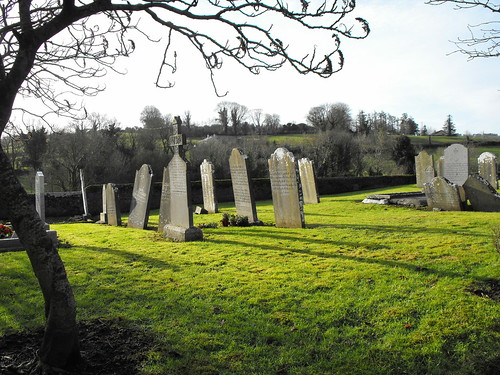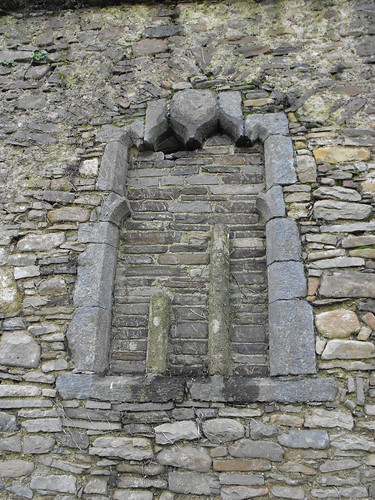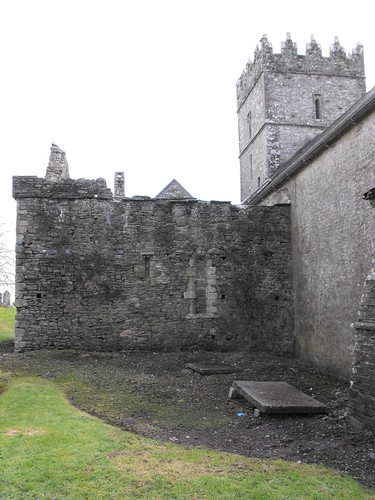OS: S 659 654 (map 61)
Longitude: 7° 1' 27.55" W
Latitude: 52° 44' 9.8" N
GPS: S 65896 65436 (Accuracy – 4m)
Description and History – When I looked this site up in the Archaeological Inventory for County Carlow I was not prepared for what I would see...this church is still used. I’m so used to finding a pile of ruins in a field somewhere that this was a welcome surprise. The only part that is ruined is the surviving transept. The rest is still a functioning church with a very interesting history. I'm not from Carlow so most of you who are from the Kildare and Leighlin diocese will probably know much more about this place so please correct me if I am wrong about anything and feel free to tell me about anything extra that you know.
A Benedictine monastery was founded at Old Leighlin in the 7th century AD by St Gobban and St Molaise (also known as St Laserian) succeeded him as abbot of the monastery. Some sources say that Molaise was the brother of Gobban. Molaise allegedly died in an act of self sacrifice when he removed a hair from St Sillan’s eyebrow which caused death to anybody who saw it. Molaise died in c. 639 and his feast day is celebrated on 18th April with a service in the church and a parade to the nearby holy well. Molaise was foreshadowed by a vision of his Gobban’s. Gobban was said to have seen angels hovering over Old Leighlin who foresaw the arrival of a man who would gather ‘God’s servants’ to the monastery. This prophecy was fulfilled in Molaise’s lifetime and by the time he died there was somewhere in the region of 1500 monks at the monastery. Oldl Leighlin them became an Episcopal See and Molaise its first bishop. The monastery was selected as the site of a synod in 630AD to settle the dispute between Ireland and Rome over when Easter should be celebrated. It was decided to adopt the Roman method for determining Easter. The diocese of Leighlin was created in 1111AD and at the synod of Rathbreasail. The diocese was combined with Kildare in 1694.
The original church buildings, which were wooden, burnt down in c. 1060AD and just under a century later work on the stone building began and was completed by the end of the 13th century. The remains of the nave and chancel are all that remains of this phase of building and are now incorporated in to the 16th century rebuilding when the transepts and tower were added. One transept is now missing and the other is ruined. The surrounding graveyard is equally as fascinating as the church and contains many ornate gravestones dating from the 17th century onwards. Also located in the graveyard is the base of a high cross. This really is a lovely site to visit and is well maintained and seems to have fallen right out of a postcard.
Difficulty – Easy to find and get around.
The original post can be found at 'The Standing Stone' and can be seen here.

This the sight that greets you on the way into the graveyard. It's a wonderful spot.
 This is the first view of the Cathedral you get.
This is the first view of the Cathedral you get.
 Sorry about the sun in this shot. Here you can see the tower and ruined transept.
Sorry about the sun in this shot. Here you can see the tower and ruined transept.
 Blocked up window in the transept.
Blocked up window in the transept.
 Lovely window on the East wall.
Lovely window on the East wall.
 Ruined transept
Ruined transept
 This is the base of the high cross that is located in the graveyard.
This is the base of the high cross that is located in the graveyard.
Longitude: 7° 1' 27.55" W
Latitude: 52° 44' 9.8" N
GPS: S 65896 65436 (Accuracy – 4m)
Description and History – When I looked this site up in the Archaeological Inventory for County Carlow I was not prepared for what I would see...this church is still used. I’m so used to finding a pile of ruins in a field somewhere that this was a welcome surprise. The only part that is ruined is the surviving transept. The rest is still a functioning church with a very interesting history. I'm not from Carlow so most of you who are from the Kildare and Leighlin diocese will probably know much more about this place so please correct me if I am wrong about anything and feel free to tell me about anything extra that you know.
A Benedictine monastery was founded at Old Leighlin in the 7th century AD by St Gobban and St Molaise (also known as St Laserian) succeeded him as abbot of the monastery. Some sources say that Molaise was the brother of Gobban. Molaise allegedly died in an act of self sacrifice when he removed a hair from St Sillan’s eyebrow which caused death to anybody who saw it. Molaise died in c. 639 and his feast day is celebrated on 18th April with a service in the church and a parade to the nearby holy well. Molaise was foreshadowed by a vision of his Gobban’s. Gobban was said to have seen angels hovering over Old Leighlin who foresaw the arrival of a man who would gather ‘God’s servants’ to the monastery. This prophecy was fulfilled in Molaise’s lifetime and by the time he died there was somewhere in the region of 1500 monks at the monastery. Oldl Leighlin them became an Episcopal See and Molaise its first bishop. The monastery was selected as the site of a synod in 630AD to settle the dispute between Ireland and Rome over when Easter should be celebrated. It was decided to adopt the Roman method for determining Easter. The diocese of Leighlin was created in 1111AD and at the synod of Rathbreasail. The diocese was combined with Kildare in 1694.
The original church buildings, which were wooden, burnt down in c. 1060AD and just under a century later work on the stone building began and was completed by the end of the 13th century. The remains of the nave and chancel are all that remains of this phase of building and are now incorporated in to the 16th century rebuilding when the transepts and tower were added. One transept is now missing and the other is ruined. The surrounding graveyard is equally as fascinating as the church and contains many ornate gravestones dating from the 17th century onwards. Also located in the graveyard is the base of a high cross. This really is a lovely site to visit and is well maintained and seems to have fallen right out of a postcard.
Difficulty – Easy to find and get around.
The original post can be found at 'The Standing Stone' and can be seen here.

This the sight that greets you on the way into the graveyard. It's a wonderful spot.
 This is the first view of the Cathedral you get.
This is the first view of the Cathedral you get. Sorry about the sun in this shot. Here you can see the tower and ruined transept.
Sorry about the sun in this shot. Here you can see the tower and ruined transept. Blocked up window in the transept.
Blocked up window in the transept. Lovely window on the East wall.
Lovely window on the East wall. Ruined transept
Ruined transept This is the base of the high cross that is located in the graveyard.
This is the base of the high cross that is located in the graveyard.
![Reblog this post [with Zemanta]](http://img.zemanta.com/reblog_e.png?x-id=9b636602-056e-4b60-9282-f1a183bbfc87)
There is an interesting grave on the right as you enter the yard of the Cathedral in which a Priest called Foley is buried along with his parents. The Priest was a nephew of Bishop Foley of K&L but the Bishop, not a victim of nepotism, thought that he wasn't fulfilling his duties as exactly as he should and removed his living from him so Fr. Foley was forced to return to live with his parents.
ReplyDeleteIs there any view of the interior of the Cathedral? It would be interesting to compare what the anglicans have done to the former Cathedral of the Diocese compared with the mess that has been made of the interior in Carlow.
ReplyDeleteI am unable to state with certainty but I think that it is unlikely that Leighlin was founded as a Benedictine Monastery in the 7th Cent. The Rule of St. Benedict certainly dominated in present-day France within a generation of the death of St. Benedict himself (c. 597) and it is true to say that is strongly influenced, if not colonized, the life of Irish Abbeys on the continent within that period. Nevertheless, with a mere 9 houses in Ireland by the time of the Reformation and given the definitive importation of the Cistercian branch of the Benedictine Order as a watershed between Celtic and Continental forms of monasticism in the mid-11th Cent., I think it highly improbable.
ReplyDeleteAnother fascinating contribution otherwise.
JSB
Another fine post. Do you know who built the Cathedral?
ReplyDeleteThe Cathedrals of England and Wales are sometimes used now for Catholic worship. Do we know if that is the case here? When was the Cathedral last used for Catholic Worship. I agree that it is a pity not to see the inside of the Cathedral. I haven't seen a clear shot of the interior and it was not open on the one occasion that I visited the ecclesiastical city of Leighlin.
ReplyDeletep.s. great posts!
ReplyDeleteIs there a high cross in Leighlin? Or is that a bullaun? A group of posts on High Crosses would be really interesting.
ReplyDeleteYou have given us a wonderful account of one of those spiritual fathers whose immense heritage we have squandered in our days. May the Holy Father's plea to the people of Ireland be heard and lived as it was when first brought to us by Saint Patrick and his spiritual sons. Thank you, standing stone. Yours is a powerful mission.
ReplyDelete